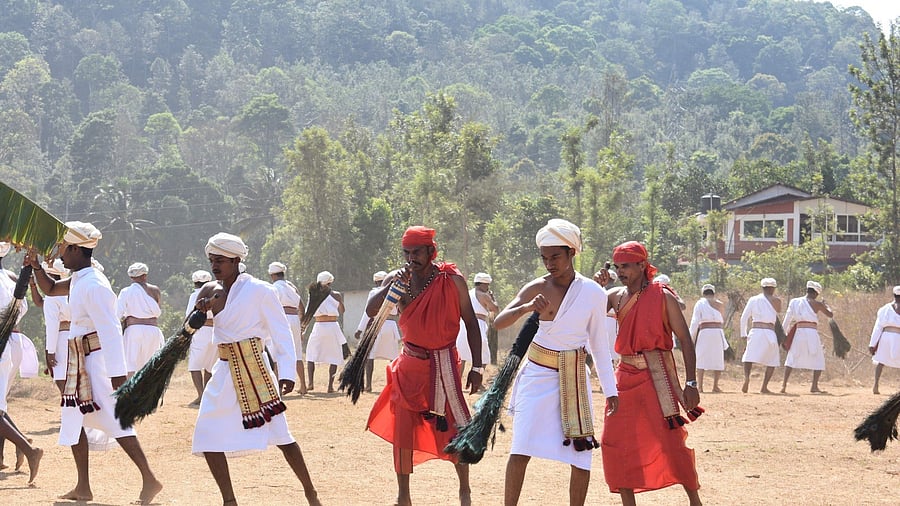
Men perform 'chowri-aat', as part of the festival celebrations.
Credit: Special arrangement
It was many years ago, during my school days, that I had an opportunity to visit the Haleri (also known as Paaleri) Bhadrakali temple in Madikeri taluk. I was especially intrigued by several antlers hung on the wooden beams through the length of the temple verandah.
Upon enquiry, the temple priest let me know that the antlers are used during the temple festival, to perform ‘kombaat.’ Kombaat is a word derived as a combination of two Kodava words — kombu (antler) and aat (dance). It is one of the ritualistic dances performed during temple festivals of Bhadrakali, a local deity of Kodagu. Ever since then, I have been trying to get more information on the schedule, so I could go to one of these festivals where kombaat is performed.
Bhadrakali, also known as Bhagavathi or Povvadi, is a local deity worshipped in every village in Kodagu. The annual festival celebrated in her honour is the ‘Povvadi namme’ or the Povvadi festival.
Finally, this year, my friend informed me that the Povvadi namme at her native village was scheduled to be held in April. After a long wait, I finally arrived at the ‘mandh’ (ground) attached to the Bhadrakali temple of Valavadi village. Ibbani and Valavadi are two sister villages in Madikeri taluk.
The annual temple festival is hosted by the communities attached to each of these villages on alternating years, in the premises of the Bhadrakali temples at the respective village. This year, it was Valavadi’s turn to host this festival.
“Witnessing a little-known and vibrant festival in such proximity to Madikeri town came as a surprise to me. The lush green hills all around add a beautiful backdrop to the dance performances,” says Ugha Devaiah, a visitor who attended the Povvadi festival at Ibbani in 2023.
History of the festival
As part of the celebrations, on the first day, the ooru thakka (village keepers), deva thakka (keepers of the temple) and bandara thakka (keepers of the temple’s valuables) arrived in a grand procession. They carried the donation box and the jewellery for the deity from its treasury to the temple. This marks the beginning of the festival.
The people were accompanied by the music of the kombu, a traditional musical instrument that resembles a brass trumpet, dudi kott, a traditional percussion instrument, and valaga, instruments played by the Meda community.
The second day began with peeli-aat, a rhythmic dance performed to drum beats by men who represent the local clan of the village. They were dressed in white robes, worn only on auspicious occasions. The men danced in a circular formation around a traditional lamp, with a bundle of peacock feathers in their hands. Post the performance, the crowd gathered around the temple.
Here, the men performed the kombu-aat and chowri-aat (dance with a cluster of yak hair) to the beats of the traditional drums. The performers circumambulated the temple while dancing with the kombu and chowri. Watching their coordination was, in itself, a spiritual experience.
The history of this festival dates back to over 300 years ago, says Malera Charan, a native of Ibbani-Valavadi. Ten types of peeli-aat are performed, with three types of antlers and chowri to mark the festival, he adds.
After the dancing, the villagers gathered to offer donations to Ajjappa (another local deity) and Bhadrakali. After everyone finished offering their prayers, they went back to the podium with haste, almost competing to get back first.
Perhaps this comes from the fact that the next ceremony is like a competition of sorts. All the native clans of the village competed against each other in a coconut-shooting competition. Three coconuts tied to a distant high pole were to be shot at as targets. This was a fun event to end the day of festivities. On the following day, there was a similar celebration, but on a smaller scale.
On the 14th day of the festival, a pooja is offered to the goddess. After this, the donation box and the temple jewellery are returned to the treasury, until next year. The last and the final day of the fortnight-long festival is marked by a kalasa pooja, before the curtains are drawn on the beautiful celebration.